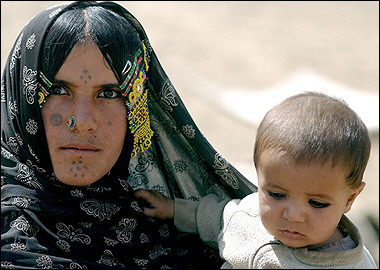ټول حقوق د منډيګک بنسټ سره محفوظ دي
The most elegant female fashion in Afghanistan belongs to the Pashtuns.. The Pashtuns use a variety of stitching techniques, which vary from one region to the next. The most elaborate embroidering is done on the bodice of the dress and the sleeve cuffs. The embroidery for the bodice can either be done on the actual fabric of the dress or at times, on a coarser material, which is then stitched onto the dress. The hem of the dress is adorned with gilded brocades and thick gilded thread that is twisted and shaped to form various designs. Contrast colors are also used to add beauty to the skirt and sleeve hems.
.
The fabric most often used to make these dresses is silk and velvet in rich colors. During the warmer seasons the women opt for printed cotton and rayon fabrics in bright colors. The combination of colors is amazingly attractive.
Underneath the dress, the women wear drawstring trousers, which are usually made from a different fabric than the dress and in contrast color. Like the sleeves, the styles of the trousers also vary. Typically, they are loose fitting on the top and gathered firmly at the waist with a string. The cuffs of the trousers can either be made to fit very tight around the ankles or they can fit loosely. Sometimes the same gilded brocades that are used on the hem of the skirts are also used to adorn the cuffs of the trousers.
As All Afghan women, Pashtun women cover their heads with colorful silk or cotton garments (Shawls). These shawls have decorative needle work borders sometime adorned with silver coins. Most of them are printed with bright colorful designs. They have different names in different areas. The most common name is Chadar or sadar. Larger covers are worn outside and smaller lightweight chadars at home.
Pashtuns wear silver jewelry with colorful stones as chokers, wide bracelets, rings, large multi earrings, and beautiful head pieces and nose ring. Also, colorful beads with beautify designs are common among Pustuns.
Blue-Green permanent beauty marks in the form of dots and patterns are sometimes tattooed between eyebrows, chin and one cheek in some rural areas on young Pashtun women. This custom was practiced as a belief to protect one from the evil eye. It became a fashion trend later, mostly among Koochees (nomads)

Sheen Khaal are blue-green permanent beauty marks in the form of dots and patterns that are usually tattooed between the eyebrows, on the chin and on the cheek of young Pashtun women. This custom was originally practiced as a way to protect ones-self from the evil eye. It used to be very common for Pashtun ladies to have sheen khaal but today it is mostly only seen on very old women or the nomads or kochi women. Sheen Khaal is still seen as very beautiful by many Pashtuns and Pashtun women nowadays sometimes make temporary sheen khaals on their faces on special occasions.
I have also been told that sheen khaal is also used as a medical treatment for pain in the muscles and body in rural areas where no medical facility is available. A skillful person takes some sewing needles and the person hits and strikes that pain spot multiple times and after it is bleeding they use ink upon that as an antiseptic and with the passage of time that spot becomes green.

















